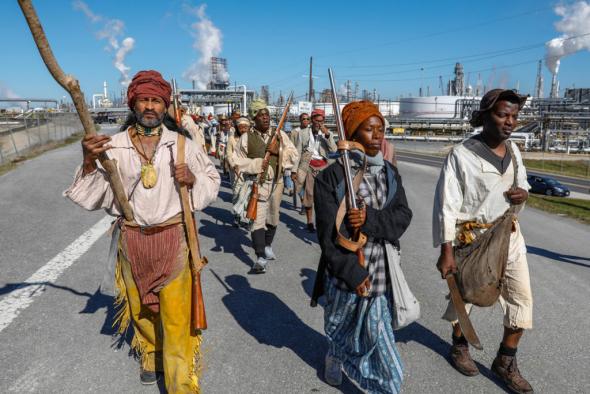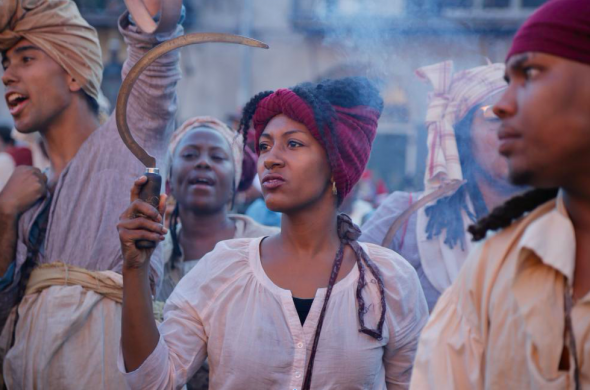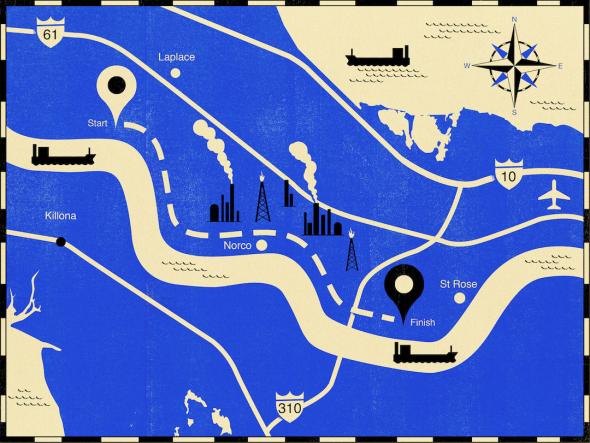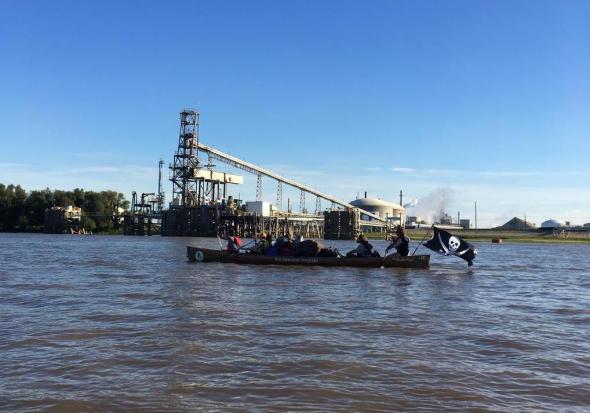Louisiana Unsettled
A journey in multiple temporalities: from the Slave Rebellion Reenactment to the chemical landscapes of the dispossessed delta
 Documentation of Slave Rebellion Reenactment, a community engaged performance initiated by Dread Scott. Performend November 8-9, 2019 in the outskirts of New Orelans. Photographed by Soul Brother
Documentation of Slave Rebellion Reenactment, a community engaged performance initiated by Dread Scott. Performend November 8-9, 2019 in the outskirts of New Orelans. Photographed by Soul Brother
Last November 9th in New Orleans I had the chance to assist to the Slave Rebellion Reenactment, a community-engaged performance organized by artist Dread Scott and documented by filmmaker John Akomfrah, that reimagined the 1811 German Coast Uprising, revisiting the “suppressed history of people with an audacious plan to organize and seize Orleans Territory, to fight not just for their own emancipation, but to end slavery.” In what was a striking gesture to claim the interruption of linear chronos, in a conservative Louisiana that endures forms of exclusionary politics as legacy of the colonial history in the region, Scott wanted to clash temporalities and disrupt the horizon of the possible, asking: “what if this rebellion was successful?”
Involving hundreds, the re-enactment took place over two days, marching from upriver New Orleans and arriving at Congo Square, a spiritually and historically-charged site where slave trade was conducted and music has echoed for centuries. Covering the 41KM where the 1811 revolt occurred, the re-enactment procession sang in Creole and English to African drumming while marching among exurban communities and industry sprawling along the Mississippi river. The performance was conjured by self-organized communities, following the nexus of the uprising itself, led by small groups plotted clandestinely. By overlapping the crowds of epoch-dressed re-enactors with the landscapes of Louisiana drowning in solastalgia, Scott’s procession wanted to provoke an “historic anomaly (that) formed a cognitive dissonance for viewers”, playing with the multiple temporalities of the possible.
The re-enactors marched through the overly polluted landscapes of the petrochemical corridor, once home to what was once called the “plantation country”, an extension of circa 400 plantations that operated from Plaque mine down to the Gulf, where the cultivation of sugar, cotton, and tobacco was supported by generations of forced labour. Slavery in the region started in 1719, abducting lives of countless inhabitants from the Senegambia region who disembarked for quarantine in Algiers point, to be sold in the over sixty known slave market sites in New Orleans. International slave trade was later banned in 1808, however illegal shipments to Louisiana continued until the 1830s.
 A reenactor holds a sickle aloft photograph by Anne Ponton.
A reenactor holds a sickle aloft photograph by Anne Ponton.
Today the aftermath of slavery is entrenched in numerous forms of exclusionary politics, that hygienized post-Katrina New Orleans, where many institutions have been shut down, schools have been fully privatized and black population reduced to 59%. Coastal management plans and the fierce presence of industry in the region also actualizes hierarchical forms of extractive labor, not accounting for the physical wellbeing of workers, who are continuously exposed to hazard manipulation, and surrounding communities, who endure through chemically-charged environments.
Most descendants of the formerly unfree inhabitants of the region, live today in the chemical corridor also know as “Cancer Alley”, an extension of 190KM, that stretches from Baton Rouge to New Orleans. “Cancer Alley”, as the name recounts, is doomed to being an exclusionary land, where zoning practices are enforced by distribution of toxicity through lower class and racialized populations. Louisiana, being one of the most intensively industrialized Delta’s in the world, is home to over 150 chemical plants, and the Mississippi filters through an enormous quantity of chemical discharges everyday. The sites of plantations are now occupied by petrochemicals and carceral institutions, often perpetuating forms of land dispossession, confining populations to a never-ending cycle of subjugation. The aftermath of slavery is imprinted in the many stratas of state and corporation-enacted violence that perpetuate the subalternization of black bodies, in what Christina Sharpe has named “the total climate of anti-blackness”. A total climate where bodies weather through and endure forms of molecular colonialism in an disappearing delta.
The scope of the extractive zone in Louisiana extends in multiple directions. This state has been built by many layers of extraction, not only of human labour, but also fossil resources, contributing to the colonial cycle of land exhaustion and human rights violation that has today banalized forms of geologic and biopolitical subjugation.The Mississippi delta accounts for 8% of total U.S. Gas reserves, and processes 3.3 million barrels of crude oil per day, while at the same time suffers from one of the harshest forms of coastal erosion due to the rise of waters. Here, the entanglements of the human with hydropower are more present than ever, and so is the carceral and necropolitical management of bodies, but also the sovereign control over non humans and inert geontologies.
 Illustration by Dan Bejar
Illustration by Dan Bejar
Recognizing the need to debate racialized forms of extraction and how they constitute contemporary zoning practices, it is perhaps is useful to address Kathryn Yusoff’s “A Billion Black Anthropocenes or none”, that re-situates the discipline’s discussion around the anthropocene accusing “a universalist geologic commons, (which) neatly erases histories of racism that were incubated through the regulatory structure of geologic relations. The racial categorization of Blackness shares its natality with mining the New World… That is, racialization belongs to a material categorization of the division of matter (corporeal and mineralogical) into active and inert.” (2) She continues: “Geology is a mechanism of power and statecraft that has a lower resolution or a more subterranean subjective operation that more performative biopolitics, but it nonetheless continues to be oppressive in its extraction qualities.” (81) I would add that, to the universalist logic of geology we can parallel the toxic release management plan (or lack thereof), and the supremacist rational behind coastal restoration strategies – which are being designed behind closed doors in models that resemble a war room, unapologetically reminding us that we live in an era of militarization of water.
After many conversations I had during my visits to Louisiana, I was pondering: what if we accounted for all labor that was put in the development of those lands, both human, and non-human, the living, the inert, and the not-yet-lived, would this then lead us to a new understanding of its environment and its constitution as a disappearing geological strata in flux? Can we interpret how the energetic metabolism speculated around the Mississippi is withholding processes of land recuperation and human health, while privileging forms of dissolved property?
 Photograph by Margarida Mendes
Photograph by Margarida Mendes
Land dispossession has haunted many generations in the delta, as plantations and big business pushed away its original inhabitants, themselves of many tribes, that preceded its occupation by thousands of years. New Orleans, also known as Bulbancha – the land of many languages – was once the home of the Chitimacha, Atakapa, Caddo, Choctaw, Houma, Natchez and Tunica. One of the vocals of this history of dispossession is photographer Monique Verdin, an inhabitant of St Bernards parish and descendent of the Houma nation, whose family has inhabited the bayous for many generations despite the lack of federal recognition. The Houmas have dedicated themselves to shrimping, an activity that has granted them survival by maintaining food sovereignty, but that is being challenged today, as the levels of salinity fiercely endanger the resilience of the disappearing marsh, that doesn’t root deeply enough to survive the raise of storm surges. Verdin herself has become an activist, documenting and narrating the disappearing land of the gulf, registering the changes in the bayou and the entangled controversies between recuperation politics and inhabitants. To the Houma, the intricate process of federal tribal recognition has proved difficult, due to the bureaucratic particularities and genetic proof requested, but also as family members conciliation is disrupted by the job monopoly held by the petrochemical industry, who at the same time contribute to the increase of land loss in the region and the displacement of communities.
“Nobody wants to go to the swamp, right?” says Verdin as we drive down along Shell Beach, one of the crucial axes of the 16.000KM of built canals that now encircle the Mississippi as its tributaries.The industrial presence in the region is highly connected to the dependency of the river as a source of hydro maintenance for refineries and chemical plants, not to mention its role as a transportation canal for international shipping. The undesirable lands of the bayous, are neighboured by an alarming number of what Verdin calls, the “river monsters” - cranes, containers barges, refineries, and other infrastructure that infuse a metallic taste in the air. And as I paddled down the petrochemical corridor reflecting on the disjunct temporalities of matter, while camping to uninterrupted pumping sounds of countless refineries now naturalized, a poem echoed in my mind:
the sleepless factory
the sub-bass of an oracular flame
pumping in the night
ungrounding the earth
foam in the river
solving through the skies
the dawn of hydrological power
now militarized
snake drifts in the sand grains,
the trace of DNA
mimetizing the cosmic moves of tomorrow
snake drifts, snake recedes
the cosmic dive
waves uncertain
rainbow parts on clouds
the chemical disentanglement drifting in divide
Further reading
The Rebellion ‘Un-Bibliography’ - activist Shana griffin has compiled an extensive ‘un-bibliography’ of texts, films, museums, and community resources, accessible in this link